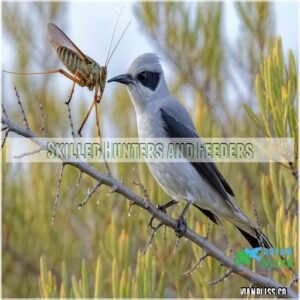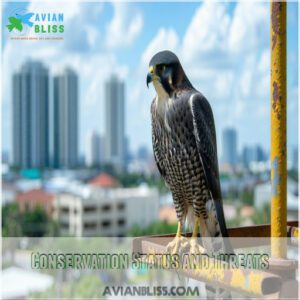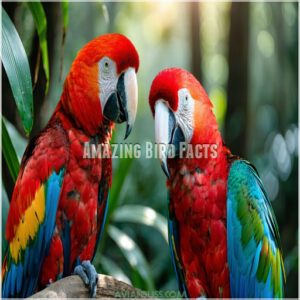This site is supported by our readers. We may earn a commission, at no cost to you, if you purchase through links.
 Exotic bird species are fascinating with their vibrant colors, intelligent behavior, and unique adaptations.
Exotic bird species are fascinating with their vibrant colors, intelligent behavior, and unique adaptations.
Parrots, for example, can mimic sounds, use tools, and form strong pair bonds that last a lifetime.
Many tropical birds, like toucans, have specialized beaks for eating fruit and seeds, while others dazzle with plumage designed for camouflage or attracting mates.
Surprisingly, some birds sleep with half their brain awake to stay alert for predators.
Their habitats, from lush rainforests to mountainous regions, shape their diets, behaviors, and survival strategies.
Conservation efforts are essential to protect these species from threats like habitat loss and illegal trade, which is crucial for maintaining biodiversity.
Table Of Contents
- Key Takeaways
- Exotic Bird Species
- Bird Habitats and Origins
- Characteristics and Behaviors
- Conservation Status and Threats
- Amazing Bird Facts
- Frequently Asked Questions (FAQs)
- What is the coolest fact about birds?
- What is the rarest exotic bird?
- What makes a bird exotic?
- What are some facts about tropical birds?
- What are the migration patterns of exotic birds?
- How do exotic birds communicate with each other?
- What do exotic bird diets mainly consist of?
- Which exotic birds show seasonal plumage changes?
- How do exotic birds adapt to climate changes?
- Conclusion
Key Takeaways
- You’ll find that exotic birds, like parrots and toucans, amaze with vibrant plumage, unique beaks, and incredible intelligence, like mimicking human speech or using tools.
- Many tropical birds adapt to their habitats with specialized traits, like sleeping with half their brain awake to stay alert for predators.
- Habitat loss and illegal trade threaten these species, making conservation efforts vital for their survival and biodiversity preservation.
- Exotic birds thrive in diverse ecosystems like rainforests, coastal areas, and mountains, with diets based on fruits, seeds, insects, and nectar.
Exotic Bird Species
You’ll find exotic bird species fascinating for their vibrant colors, unique features, and remarkable adaptations.
These birds, like parrots and toucans, showcase incredible diversity in their plumage, beak shapes, and behaviors.
Parrots and Their Characteristics
Parrots are incredible exotic bird species, known for their intelligence, vibrant feather colors, and unique beak shapes.
They’re highly social, forming strong bonds and showcasing fascinating behaviors. Parrots can have remarkably long lifespans, some living comparably to humans.
Here are some facts:
- Parrot intelligence lets them mimic speech and use tools.
- Their colorful plumage is eye-catching and aids communication.
- Mating habits often include lifelong pair bonds.
Their unique characteristics, such as vibrant feather colors, make them stand out among other bird species.
Unique Features of Tropical Birds
Tropical birds fascinating features that showcase their vibrant habitats.
Their Tropical Beaks are perfect for harvesting fruit, cracking seeds, or sipping nectar.
Bird feeding behaviors are essential for ecosystem health, impacting species evolution and survival.
Bird Scales protect their legs while traversing rough terrain.
Feather Colors reflect striking biodiversity, aiding camouflage and mating.
Wing Patterns boost agility for survival in dense rainforests, making every flap a masterpiece of exotic bird characteristics.
Specialized bird feeding adaptations influence their diets and foraging techniques.
| Unique Trait | Function | Example |
|---|---|---|
| Tropical Beaks | Cracking seeds, foraging | Toucans |
| Bird Scales | Protection, grip | Parrots |
| Feather Colors | Camouflage, attraction | Scarlet Ibis |
| Wing Patterns | Flight in dense habitats | Macaws |
Colorful Plumage and Beak Shapes
The domain of exotic bird species dazzles with vibrant feathers and striking plumage colors.
Bird textures range from sleek to fluffy, while feather patterns highlight individuality.
Many species exhibit striking plumage characteristics, adapted for their unique environments.
Beak shapes do more than look unique—they’re tools for eating, climbing, or nesting.
Tropical bird species like macaws and toucans showcase vibrant colors, making them unforgettable examples of nature’s artistry among colorful bird species worldwide.
Bird Habitats and Origins
Exotic bird species live in some of the planet’s most stunning and diverse ecosystems. From lush tropical forests to quiet freshwater habitats, their choice of home often reflects their unique needs.
Coastal environments attract birds like seagulls, while rainforest birds thrive in the dense canopy, full of food and shelter. Mountainous regions house species like the Resplendent Quetzal, acclimated to cooler altitudes.
Birds thrive in unique bird habitats across the globe.
- Tropical forests offer vibrant settings for parrots and lorikeets.
- Coastal environments support adaptable birds like seagulls and herons.
- Mountainous regions provide shelter for birds like quetzals.
- Freshwater habitats attract birds with aquatic diets, including cormorants.
Each exotic bird species mirrors its habitat, showing nature’s creativity in helping them adapt and flourish.
Characteristics and Behaviors
Exotic birds show fascinating behaviors, including unique sleeping patterns and social habits. Their vibrant plumage, specialized feeding techniques, and flocking instincts highlight the diversity of their traits.
Sleeping Patterns and Resting Postures
Bird sleep is fascinating.
Some species, like sea gulls, sleep with one brain hemisphere alert, ensuring safety.
Eye closure varies—birds may appear awake while resting.
Birds often utilize avian sleep patterns for survival.
Exotic bird behaviors, like balancing on one leg (leg rest), conserve heat during nighttime perch.
Roosting behavior adapts to surroundings, with sleeping patterns tuned for unique adaptations and survival.
Bird resting postures highlight their adaptations.
Skilled Hunters and Feeders
Carnivorous birds showcase extraordinary hunting tactics and feeding strategies.
Northern shrikes, for example, impale prey on sharp objects for later meals, earning the nickname "butcher birds."
Toucan beaks, colorful and prominent, aid in foraging methods.
Owls swallow prey whole and regurgitate pellets.
These behaviors demonstrate how exotic bird species adapt their diets and habits to thrive as skilled aquatic predators or scavenger birds.
Social Birds and Flocking Behavior
Flocking behavior showcases the incredible group dynamics of social birds.
Many exotic bird species, like parrots and flamingos, thrive in colonies, relying on bird communication for safety and organization.
Through social learning, birds share knowledge about food sources and predators, which strengthens survival, as individuals benefit from collective effort.
Understanding flock dynamics offers fascinating bird species information, highlighting nature’s ingenuity.
Conservation Status and Threats
You’ll find that many exotic bird species face serious threats due to habitat destruction and illegal wildlife trade.
Conservation efforts, like breeding programs and stricter protection laws, work to protect these remarkable creatures from extinction, which is a key aspect of preventing their disappearance due to illegal wildlife trade.
Habitat Loss and Destruction
Habitat loss threatens exotic bird habitats globally, often due to deforestation effects and environmental degradation.
Ecosystem disruption follows habitat destruction, leading to wildlife decline.
Conservation efforts aim to address these challenges.
Here’s how habitat fragmentation impacts:
- Endangered bird species face survival challenges.
- Nesting sites disappear.
- Food sources shrink.
- Migration becomes harder.
- Biodiversity decreases drastically, which is a result of habitat destruction.
Illegal Trade and Wildlife Protection
The illegal trade of exotic bird species threatens global biodiversity.
Wildlife smuggling and lax trade regulations endanger species, accelerating habitat loss.
Poaching laws aim to curb this, but stronger wildlife protection laws are needed.
Conservation efforts focus on enforcement and educating communities.
Protecting endangered species requires global cooperation, ensuring habitat preservation and stricter penalties for offenders involved in this harmful trade.
Endangered Species and Breeding Programs
Although many exotic bird species face extinction, conservation efforts offer hope.
Breeding programs play a key role in saving endangered birds, ensuring their numbers grow.
Over 1,400 bird species face extinction according to current endangered bird lists.
Here are some ways they help:
- Protect species through controlled breeding.
- Aid habitat preservation by raising awareness.
- Reintroduce birds into the wild.
- Strengthen wildlife protection laws globally.
Conservation efforts, including breeding programs and habitat preservation, are crucial for the survival of these species.
Amazing Bird Facts
You’ll be amazed at how intelligent and resourceful birds can be, from parrots that mimic human speech to social species forming flocks of hundreds.
Their vibrant plumage and unique traits, like colorful beaks or one-legged resting habits, reveal nature’s stunning creativity, showcasing nature’s ability to inspire.
Intelligent and Social Birds
How do birds show their smarts? Parrot intelligence stands out among exotic bird species, showcasing remarkable communication skills and problem-solving abilities.
Social birds like parrots bond deeply, using flock dynamics to navigate their world. Parrot species often display fascinating bird behavior, working in groups and performing intricate mating rituals.
These unique abilities highlight the incredible social behavior and intelligence seen in nature.
Vibrant Plumage and Colorful Displays
Exotic bird species captivate with their vibrant colors and mesmerizing plumage patterns. You can’t help but notice how iridescence effects make feather textures shimmer beautifully.
Many products showcase exotic bird plumage in striking ways.
Colorful birds like parrots and macaws use dazzling displays to attract mates or camouflage.
Look closely, and you’ll see:
- Stunning metallic blues on Lear’s Macaws.
- Golden wing shades on pheasants.
- Colorful bird plumage highlighting unique beak shapes.
Unique Traits and Characteristics of Exotic Birds
From dazzling plumage colors to remarkable beak shapes, exotic bird characteristics never fail to amaze.
Wing structures enable swift flight or graceful gliding, while feather patterns provide camouflage or attract mates.
Bird intelligence shines in unusual bird species like parrots, known for mimicking voices.
Explore unique exotic bird traits products available online.
These amazing bird facts showcase how exotic bird species are marvels of nature’s design and evolution.
Frequently Asked Questions (FAQs)
What is the coolest fact about birds?
Did you know some birds sleep with only half their brain?
It’s true! This amazing adaptation lets them rest while staying alert to danger, balancing safety and survival—talk about multitasking mastery in the wild!
What is the rarest exotic bird?
The rarest exotic bird is the Kakapo, a nocturnal, flightless parrot from New Zealand.
With fewer than 250 individuals left, it faces extinction due to habitat destruction and predators like cats and rats.
What makes a bird exotic?
Imagine a feathered masterpiece strutting into a bird fashion show.
An exotic bird typically wows you with vivid colors, unusual features, or rare habitats, often hailing from distant lands with unique behaviors or lifestyles.
This exotic bird is a true marvel, and its rare habitats are a key part of its allure.
What are some facts about tropical birds?
Tropical birds, like toucans and quetzals, flaunt vibrant plumage, often adapted for camouflage or mating.
They thrive in rainforests, showcasing diverse diets, from fruits to insects.
They face threats like habitat loss, needing urgent conservation efforts.
What are the migration patterns of exotic birds?
Exotic bird migration varies by species.
Some, like flamingos, move seasonally for warmer climates or water sources, while others, like parrots, stay local.
Factors include food availability, breeding needs, and environmental changes.
How do exotic birds communicate with each other?
Ever wonder how exotic birds chat?
They use calls, songs, and body language like dancing or feather flaring.
Each creates unique sounds to warn, attract mates, or bond.
It’s nature’s way of keeping everyone tuned in with unique sounds.
What do exotic bird diets mainly consist of?
Exotic birds eat fruits, seeds, nuts, nectar, and insects.
Parrots love seeds and fruits, while toucans enjoy juicy fruits and insects.
Birds adapt their diets to habitats, using specialized beaks to access food efficiently.
Which exotic birds show seasonal plumage changes?
Some exotic birds, like ptarmigans and some species of ducks, display seasonal plumage changes.
Their feathers shift between vibrant summer colors and muted winter tones, helping them blend into their environment and stay safe from predators.
How do exotic birds adapt to climate changes?
Exotic birds adapt to climate changes by shifting habitats, altering migration patterns, and adjusting breeding seasons.
Their feathers often regulate temperature, while diet flexibility helps them survive as environments and food sources change unpredictably, which is crucial for their survival in unpredictably changing conditions.
Conclusion
Imagine a macaw in a rainforest, using its strong beak to crack open seeds while its vibrant feathers flash through the trees.
Exotic bird species like this show how diversity shapes ecosystems. From parrots mimicking sounds to toucans thriving with specialized beaks, these birds reveal nature’s creativity.
Their unique traits and habitats inspire awe, but threats like habitat loss endanger them.
Discover amazing facts about exotic bird species and help protect these incredible creatures for future generations.
- https://www.oddee.com/item_98487.aspx
- https://www.thesprucepets.com/most-uncommon-pet-birds-390527
- https://www.onegreenplanet.org/animalsandnature/7-things-you-never-knew-about-the-exotic-bird-trade-and-how-you-can-help/
- https://7esl.com/exotic-birds/
- https://support.ebird.org/en/support/solutions/articles/48001218430-exotic-and-introduced-species-in-ebird









